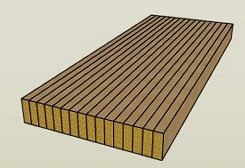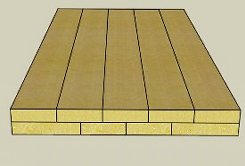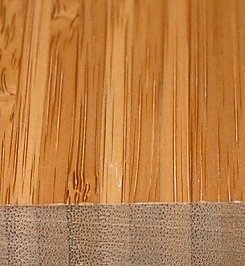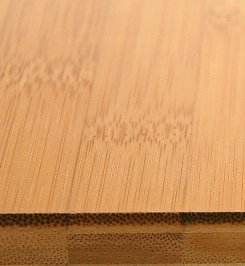Bamboo Cabinets
If you're looking for a cabinet choice that offers a bit of individuality and won't be found in the next house down the street, bamboo cabinets might be your answer.
Bamboo cabinets offer several benefits and a visual appeal that's uniquely different from cabinetry that's made with more traditional materials.
Bamboo cabinets also offer an alternative to the mass-produced stock cabinets made with a good percentage of particle board and medium density fiberboard (MDF). That's because most bamboo cabinets are made with solid bamboo and/or bamboo plywood.
If you're cautious about how bamboo cabinets might look based on having seen bamboo furniture in the past, don't fret. Bamboo has many personalities and can be stained like traditional woods.
So read on to take a closer look at bamboo cabinetry and see if it's a possibility for your next cabinet choice.
Some Basic Bamboo Facts
A Grass That's Hard, Strong And Renewable
Bamboo, despite it's look and feel, is a grass and not a wood. But don't let that fool you. Bamboo is a hard and strong material, having been used for centuries and still used today in many cultures as a prime building material. Photo Courtesy Of BambooCabinets.com
Photo Courtesy Of BambooCabinets.com
Regardless of its botanical classification, what makes bamboo unique and why it's becoming more prevalent is the fact that it's highly renewable and sustainable.
Bamboo has the ability to grow and mature within about 7 years, sometimes sooner. Compare that to hardwood trees that take decades to reach the age when they can be harvested for lumber.
The bamboo plant also remains intact when the bamboo "culms" (the bamboo stalks) are harvested, allowing the regeneration of new culms for future harvests. Hardwood trees on the other hand are consumed at harvest.
Under proper management, bamboo plants provide a valuable building material quickly and sustainably, making bamboo a good choice for green cabinets.
 Photo Courtesy of BambooCabinets.com
Photo Courtesy of BambooCabinets.com
Another benefit of bamboo is its hardness. While this attribute it certainly beneficial for flooring, it has its advantages with cabinets too. Cabinet doors and frames get banged around over time and the harder materials do better than softer ones.
Different Grain Orientation Provides Different Looks
Bamboo products come with three distinct appearances based on the bamboo's grain orientation. But describing bamboo's grain requires a little explanation of how bamboo 'boards' are made. Photo Courtesy of BambooCabinets.com
Photo Courtesy of BambooCabinets.com
The hollow and relatively narrow stalks that characterize bamboo prevent it from being milled into wide planks like lumber from large trees. Rather, the bamboo stalks are sliced into strips and then laminated (glued) together to form boards and planks. The way those strips are oriented with respect to each other and the surface of the resulting board determines bamboo's "grain orientation".
Vertical grain bamboo means the edges of these strips form the outer surface of the bamboo panel, sort of like stacking dominoes next to each other.
Horizontal grain results when the bamboo strips are laminated together on their edges, with their wider faces making up the board's surface. Think of dominoes side by side with the white dots face-up and you'll get the picture.

|

|
|
| Vertical Grain | Horizontal Grain |
What's notable about horizontal grain is that this style shows off the characteristic node or "kuckle" that's typical of bamboo stalks as shown in the picture below.
Vertical grain on the other hand looks more like wood grain, typically a wood's edge grain. An example is shown below on the left.

|

|
|
| Vertical Grain | Horizontal Grain |
One final form of bamboo you may encounter is called strand-woven. Strand-woven bamboo results from the combination of bamboo fibers and adhesives under very high pressures. The resulting material is very dense and hard.
Considerations In Choosing Bamboo Cabinets
There are a number of positives associated with bamboo cabinetry, like it's sustainable raw materials and unique aesthetic appeal. But like any product, there are considerations you need to think about to determine if it's a good fit for your particular situation.
- Don't Overlook Good Quality Construction - The quality of cabinet construction has a lot to do with their longevity and your ultimate satisfaction with them. Regardless of whether you choose bamboo or some other material, pay attention to those features that provide durability and quality.
- An Alternative To Particle Board - If you're not a fan of the mass-produced cabinets made with a hefty percentage of particle board, bamboo cabinets may be a good choice as they're typically made with solid bamboo or bamboo plywood, without the particle board. Since bamboo panels are engineered with adhesives, choose a maker that uses low or no formaldehyde bamboo.
- Bamboo Cabinets Available Custom or RTA - Bamboo cabinets, like their wood counterparts, are available as custom-built units as well as RTA (Ready To Assemble). The latter form makes it easy for do-it-yourselfers to obtain and install bamboo cabinets. They're shipped in a knocked-down format and designed to be easily assembled and installed.
- Adhesives, Finish and Indoor Air Quality - Consider the adhesives used in the raw materials that make up bamboo cabinetry as well as the finish. Low VOC (Volatile Organic Compounds) finishes and low or no-added formaldehyde materials make for a greener and healthier indoor air environment.
- Bamboo Cabinet "Green-ness" Depends on Perspective - Remember that a lot of the bamboo that comes to North America or Europe typically originates in distant geographic locations. That increases the embodied energy costs (such as transportation) and environmental impact of this otherwise renewable material.
If you're a stickler on being as green as possible this may be something to consider. Alternatives might involve using cabinets that use more local renewable resources like wheatboard, reclaimed wood or locally sourced wood.
- Bamboo is Dimensionally Stable - This is just a techie way of saying that bamboo doesn't swell and contract as much as wood. This can be an advantage in the kitchen or bathroom where higher moisture levels are present which causes wood to swell and doors and drawers to stick.
- All Bamboo Is Not Created Equal - Bamboo is touted as being hard and eco-friendly. But harvesting before its time can result in sub-standard material properties. Stories exist of dented bamboo floors despite advertised claims of bamboo being practically as hard as steel. Improper management and increased demand for bamboo also threatens its continued sustainability. Check with any bamboo cabinet maker to best understand where the bamboo comes from and how it's processed to ensure you're getting quality material from reputable sources.
Where To Find Bamboo Cabinets
 Photo Courtesy of BambooCabinets.com
Photo Courtesy of BambooCabinets.com
Bamboo might not be the most prevalent material choice for cabinetry (yet!) but you can still find them. The first place to start may be your local cabinet makers.
Bamboo materials like bamboo plywood used to make cabinets are readily available. You might query some local custom cabinet makers in your area to see if they could design bamboo cabinetry for you using bamboo materials.
If local sources don't pan out, click here to go to our bamboo cabinets resources page. There you'll find a list of sources that design and make bamboo cabinets along with some information about what each source has to offer and their website address.
Here's More Related Info That Might Be Helpful...
Choosing Kitchen Cabinets - Feeling a bit overwhelmed about choosing new kitchen cabinets? Get the low-down on what you should know and consider in this article on choosing new kitchen cabinets.
Kitchen Cabinet Quality - Cabinets come in a range of quality levels. Learn how to spot quality so you end up with cabinets that will live up to your expectations.
Buying Kitchen Cabinets Online - You're not limited to a local big-box store or local cabinet shop for new cabinets. Find out how to buy your cabinets online and how to navigate the process.
